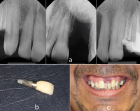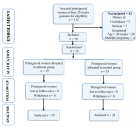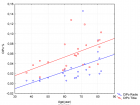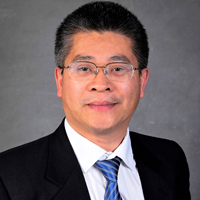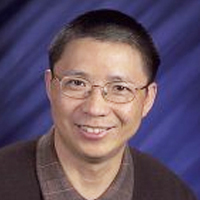Abstract
Research Article
Statistical Study of Membrane Performance for Different Pharmaceutical Compounds Removal
Iborra-Clar MI*, Carlos S and Martón I
Published: 31 January, 2024 | Volume 8 - Issue 1 | Pages: 014-026
One of the most important emerging pollutants is pharmaceutical active compounds, which may be responsible, for example, for ecotoxicological changes and microbiological resistance. Wastewater treatment plants are not adequately equipped to remove all of the emerging pollutants contained in the wastewater. The ultrafiltration process has been proven to be effective in traditional wastewater treatment, so it is important to assess the performance of such a technique in the partial elimination of pharmaceutical compounds to avoid contamination. In this work, an assessment of ultrafiltration process operating conditions for eliminating six pharmaceutical compounds: Ibuprofen, Acetaminophen, Naproxen, Diclofenac, Caffeine, and trimethoprim, present in different types of water is performed.
Experimental design is a systematic and structured approach to conducting experiments, and its application can significantly improve the study of membrane technology, reducing the number of assays necessary to obtain meaningful results. The statistical principles application ensures that the results obtained are reliable and representative of the true effects of the variables being studied. Its application helps to obtain valid conclusions from the data and provides a solid basis for making decisions or recommendations regarding the tests and variables to take into account. Membrane processes can involve complex interactions between several factors. Experimental design helps to identify and understand these interactions, allowing researchers to discern the combined effects of different variables. This is crucial to accurately predict and optimize membrane performance.
In this work, ANOVA analysis has been carried out in order to determine the influence of membrane cut-off, solution pH, and feed concentration, as well as their interactions, in permeate flux and the rejection index. The results obtained show similar behavior for Ibuprofen, Naproxen, Diclofenac, and Trimethoprim, being the pH the most important factor. However, no significant factors were found for the acetaminophen and the Caffeine.
Read Full Article HTML DOI: 10.29328/journal.acr.1001088 Cite this Article Read Full Article PDF
Keywords:
Membrane performance; Pharmaceutical compound; Ultrafiltration membrane; ANOVA; Rejection index; Permeate flux
References
- Riva F, Zuccato E, Davoli E, Fattore E, Castiglioni S. Risk assessment of a mixture of emerging contaminants in surface water in a highly urbanized area in Italy. J Hazard Mater. 2019 Jan 5; 361:103-110. doi: 10.1016/j.jhazmat.2018.07.099. Epub 2018 Aug 2. PMID: 30176408.
- Kesari EtAl. Kesari KK, Soni R, Jamal QMS. Wastewater Treatment and Reuse: a Review of its Applications and Health Implications. Water Air Soil Pollut. 2021; 232: 208. https://doi.org/10.1007/s11270-021-05154-8
- Meffe R, de Bustamante I. Emerging organic contaminants in surface water and groundwater: a first overview of the situation in Italy. Sci Total Environ. 2014 May 15; 481:280-95. doi: 10.1016/j.scitotenv.2014.02.053. Epub 2014 Mar 4. PMID: 24602913.
- Rizzo L, Malato S, Antakyali D, Beretsou VG, Đolić MB, Gernjak W, Heath E, Ivancev-Tumbas I, Karaolia P, Lado Ribeiro AR, Mascolo G, McArdell CS, Schaar H, Silva AMT, Fatta-Kassinos D. Consolidated vs new advanced treatment methods for the removal of contaminants of emerging concern from urban wastewater. Sci Total Environ. 2019 Mar 10; 655:986-1008. doi: 10.1016/j.scitotenv.2018.11.265. Epub 2018 Nov 20. PMID: 30577146.
- Marcantonio Di, Marcantonio Di. Fate and Removal of Emerging Contaminants in Water and Wastewater Treatment Plants. Rome, Italy. 2020.
- Martín-Pozo L, de Alarcón-Gómez B, Rodríguez-Gómez R, García-Córcoles MT, Çipa M, Zafra-Gómez A. Analytical methods for the determination of emerging contaminants in sewage sludge samples. A review. Talanta. 2019 Jan 15; 192:508-533. doi: 10.1016/j.talanta.2018.09.056. Epub 2018 Sep 19. PMID: 30348425.
- Nanusha MY, Frøkjær EE, Liigand J, Christensen MR, Hansen HR, Hansen M. Unravelling the occurrence of trace contaminants in surface waters using semi-quantitative suspected non-target screening analyses. Environ Pollut. 2022 Dec 15; 315:120346. doi: 10.1016/j.envpol.2022.120346. Epub 2022 Oct 3. PMID: 36202272.
- Li P, Karunanidhi D, Subramani T, Srinivasamoorthy K. Sources and Consequences of Groundwater Contamination. Arch Environ Contam Toxicol. 2021 Jan;80(1):1-10. doi: 10.1007/s00244-020-00805-z. Epub 2021 Jan 2. PMID: 33386943; PMCID: PMC7778406.
- Alfaia etAl, Alfaia R, Almeida R, Soares S, Carbonelli J. Landfill leachate pretreatment effects on nanofiltration and reverse osmosis membrane performance. Process Safety and Environmental Protection. 2023; 172. https://doi.org/10.1016/j.psep.2023.02.038
- Huang Z, Gong B, Huang CP, Pan SY, Wu P, Dang Z, Chiang PC. Performance evaluation of integrated adsorption-nanofiltration system for emerging compounds removal: Exemplified by caffeine, diclofenac and octylphenol. J Environ Manage. 2019 Feb 1; 231:121-128. doi: 10.1016/j.jenvman.2018.09.092. Epub 2018 Oct 16. PMID: 30340131.
- Tran NH, Reinhard M, Gin KY. Occurrence and fate of emerging contaminants in municipal wastewater treatment plants from different geographical regions-a review. Water Res. 2018 Apr 15;133:182-207. doi: 10.1016/j.watres.2017.12.029. Epub 2017 Dec 28. PMID: 29407700.
- Lopez FJ, Pitarch E, Botero-Coy AM, Fabregat-Safont D, Ibáñez M, Marin JM, Peruga A, Ontañón N, Martínez-Morcillo S, Olalla A, Valcárcel Y, Varó I, Hernández F. Removal efficiency for emerging contaminants in a WWTP from Madrid (Spain) after secondary and tertiary treatment and environmental impact on the Manzanares River. Sci Total Environ. 2022 Mar 15; 812:152567. doi: 10.1016/j.scitotenv.2021.152567. Epub 2021 Dec 22. PMID: 34952067.
- Huang Z, Wu P, Lu Y, Wang X, Zhu N, Dang Z. Enhancement of photocatalytic degradation of dimethyl phthalate with nano-TiO2 immobilized onto hydrophobic layered double hydroxides: a mechanism study. J Hazard Mater. 2013 Feb 15;246-247:70-8. doi: 10.1016/j.jhazmat.2012.12.016. Epub 2012 Dec 17. PMID: 23287410.
- Alvarez-Corena JR, Bergendahl JA, Hart FL. Advanced oxidation of five contaminants in water by UV/TiO2: Reaction kinetics and byproducts identification. J Environ Manage. 2016 Oct 1; 181:544-551. doi: 10.1016/j.jenvman.2016.07.015. Epub 2016 Aug 5. PMID: 27423767.
- Zhou Y, Zhu N, Guo W, Wang Y, Huang X, Wu P, Dang Z, Zhang X, Xian J. Simultaneous electricity production and antibiotics removal by microbial fuel cells. J Environ Manage. 2018 Jul 1; 217:565-572. doi: 10.1016/j.jenvman.2018.04.013. Epub 2018 Apr 7. PMID: 29635189.
- Ashrafi ETAl, Ashrafi H, Pourmahmoud N, Mirzaee I, Ahmadi N. Performance improvement of proton-exchange membrane cells through different gas injection channel geometries. Energy Research. 2022; 46: 7. https://doi.org/10.1002/er.7755
- Lujan-Facundo ETAl, Lujan-Facundo MJ, Iborra-Clar MI. Pharmaceutical compounds removal by adsorption with commercial and reused carbon coming from a drinking water treatment plant. J. of Clean. Prod. 2019; 238. https://doi.org/10.1016/j.jclepro.2019.117866
- Yang, Hu, Yang YX, Hu XJ. Decontamination of tetracycline by thiourea-dioxide-reduced magnetic graphene oxide: effects of pH, ionic strength, and humic acid concentration. J. Colloid Interf. Sci. 2018; 495. https://doi.org/10.1016/j.jcis.2017.01.075
- Ahmed MJ. Adsorption of non-steroidal anti-inflammatory drugs from aqueous solution using activated carbons: Review. J Environ Manage. 2017 Apr 1; 190:274-282. doi: 10.1016/j.jenvman.2016.12.073. Epub 2017 Jan 4. PMID: 28063293.
- Garcia-Ivars J, Martella L, Massella M, Carbonell-Alcaina C, Alcaina-Miranda MI, Iborra-Clar MI. Nanofiltration as tertiary treatment method for removing trace pharmaceutically active compounds in wastewater from wastewater treatment plants. Water Res. 2017 Nov 15; 125:360-373. doi: 10.1016/j.watres.2017.08.070. Epub 2017 Sep 1. PMID: 28881212.
- Wang J, Wang S. Removal of pharmaceuticals and personal care products (PPCPs) from wastewater: A review. J Environ Manage. 2016 Nov 1; 182:620-640. doi: 10.1016/j.jenvman.2016.07.049. Epub 2016 Aug 20. PMID: 27552641.
- Vona A, Martino DIF. Comparison of different removal techniques for selected pharmaceuticals. J. Water Process. Eng. 2015; 5. http://dx.doi.org/10.1016/j.jwpe.2014.12.0112214-7144/
- SUEZ UF. Membranes to be used in process upgrade at major WWTP in IsraelMembrane Technology. 2019; 6. https://doi.org/10.1016/S0958-2118(19)30101-6
- Abuwatfa WH, AlSawaftah N, Darwish N, Pitt WG, Husseini GA. A Review on Membrane Fouling Prediction Using Artificial Neural Networks (ANNs). Membranes (Basel). 2023 Jul 24;13(7):685. doi: 10.3390/membranes13070685. PMID: 37505052; PMCID: PMC10383311.
- Van DBB, Mänttäri M, Nyström M. Drawbacks of applying nanofiltration and how to avoid them: A review. Sep. and Pur. Tech. 2008; 63: 251-263. https://doi.org/10.1016/j.seppur.2008.05.010
- Kang G, Baek Y, Yoo JB. Relationship between surface hydrophobicity and flux for membrane separation. RSC Advances. 2022. DOI: 10.1039/d0ra07262a
- Xiao K, Wang X. Combined effect of membrane and foulant hydrophobicity and surface charge on adsorptive fouling during microfiltration. J. of Mem. Sc. 2011; 373: 1-2; 140-151. https://doi.org/10.1016/j.memsci.2011.02.041
- Garcia-Ivars J, Iborra-Clar MI, Alcaina-Miranda MI, Van der Bruggen B. Comparison between hydrophilic and hydrophobic metal nanoparticles on the phase separation phenomena during formation of asymmetric polyethersulphone membranes. J. of Mem. Sc. 2015; 493: (1). https://doi.org/10.1016/j.memsci.2015.07.009
- Nitti F. Selan O, Hoque B, Tambaru D. Improving the performance of polymer inclusion membranes in separation process using alternative base polymers: A review. Journal of Chemistry. 2022; 22: 1. https://doi.org/10.22146/ijc.68311
- Yu CH, Wu CH, Lin CH, Hsiao CH, Lin CF. Hydrophobicity and molecular weight of humic substances on ultrafiltration fouling and resistance. Sep. Purif. Technol. 2008; 64: 206-212. https://doi:10.1016/j.seppur.2008.10.008
- Trinh TA, Li W, Chew JW. Internal fouling during microfiltration with foulants of different surface charges. Journal of Membrane Science. 2020; 602. https://doi.org/10.1016/j.memsci.2020.117983
- Leo CP, Cathie Lee WP, Ahmad AL, Mohammad AW. Polysulfone membranes blended with ZnO nanoparticles for reducing fouling by oleic acid. Sep. Purif. Technol. 2012; 89. https://doi.org/10.1016/j.seppur.2012.01.002
- Sotto A, Boromand A, Zhang R, Luis P, Arsuaga JM, Kim J, Van der Bruggen B. Effect of nanoparticle aggregation at low concentrations of TiO2 on the hydrophilicity, morphology, and fouling resistance of PES-TiO2 membranes. J Colloid Interface Sci. 2011 Nov 15;363(2):540-50. doi: 10.1016/j.jcis.2011.07.089. Epub 2011 Aug 11. PMID: 21875711.
- Gracia-Lor E, Sancho JV, Serrano R, Hernández F. Occurrence and removal of pharmaceuticals in wastewater treatment plants at the Spanish Mediterranean area of Valencia. Chemosphere. 2012 Apr;87(5):453-62. doi: 10.1016/j.chemosphere.2011.12.025. Epub 2012 Jan 4. PMID: 22221664.
- Garcia-Ivars J, Martella L, Massella M, Carbonell-Alcaina C, Alcaina-Miranda MI, Iborra-Clar MI. Nanofiltration as tertiary treatment method for removing trace pharmaceutically active compounds in wastewater from wastewater treatment plants. Water Res. 2017 Nov 15; 125:360-373. doi: 10.1016/j.watres.2017.08.070. Epub 2017 Sep 1. PMID: 28881212.
- García-Ivars J, Dura-Maria J, Moscardo-Carreño C, Carbonell Alcaina C, AlcainaMiranda MI, Iborra Clar MI. Rejection of trace pharmaceutically active compounds present in municipal wastewaters using ceramic fine ultrafiltration membranes: Effect of feed solution pH and fouling phenomena. Separation and Purification Technology. 2017; 175. https://doi.org/10.1016/j.seppur.2016.11.027
- Ganiyu ED, Van Hullebusch M, Cretin G, Esposito MA. Oturan, Coupling of membrane filtration and advanced oxidation processes for removal of pharmaceutical residues: a critical review, Sep. Purif. Technol. 2015; 156. https://doi.org/10.1016/j.seppur.2015.09.059
- Statgraphics Centurion, XVIII. Statpoint Technologies. INC. Version. 2018; 18:1; 13.
Figures:

Figure 1

Figure 2
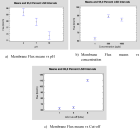
Figure 3
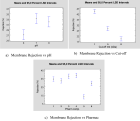
Figure 4

Figure 5

Figure 6
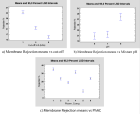
Figure 7

Figure 8

Figure 9
Similar Articles
-
Statistical Study of Membrane Performance for Different Pharmaceutical Compounds RemovalIborra-Clar MI*, Carlos S, Martón I. Statistical Study of Membrane Performance for Different Pharmaceutical Compounds Removal. . 2024 doi: 10.29328/journal.acr.1001088; 8: 014-026
Recently Viewed
-
Unveiling the Impostor: Pulmonary Embolism Presenting as Pneumonia: A Case Report and Literature ReviewSaahil Kumar,Karuna Sree Alwa*,Mahesh Babu Vemuri,Anumola Gandhi Ganesh Gupta,Nuthan Vallapudasu,Sunitha Geddada. Unveiling the Impostor: Pulmonary Embolism Presenting as Pneumonia: A Case Report and Literature Review. J Pulmonol Respir Res. 2025: doi: 10.29328/journal.jprr.1001065; 9: 001-005
-
Comparison of Trigger Point Lidocaine Injection and Stabilization Splint Use in Myofascial Orofacial Pain TreatmentAyşegül Pulatkan, Müge Çına*. Comparison of Trigger Point Lidocaine Injection and Stabilization Splint Use in Myofascial Orofacial Pain Treatment. J Clin Adv Dent. 2024: doi: 10.29328/journal.jcad.1001045; 8: 040-046
-
Euthanasia: Growing Acceptance amid Lingering ReluctanceTshibambe N Tshimbombu,Immanuel Olarinde,Judea Wiggins*,Maxwell Vergo. Euthanasia: Growing Acceptance amid Lingering Reluctance. Clin J Nurs Care Pract. 2025: doi: 10.29328/journal.cjncp.1001058; 9: 001-006
-
Why Down-managing Backlog Forensic DNA Case Entries MattersJH Smith*, JS Horne. Why Down-managing Backlog Forensic DNA Case Entries Matters. J Forensic Sci Res. 2024: doi: 10.29328/journal.jfsr.1001056; 8: 001-008
-
Environmental Factors Affecting the Concentration of DNA in Blood and Saliva Stains: A ReviewDivya Khorwal*, GK Mathur, Umema Ahmed, SS Daga. Environmental Factors Affecting the Concentration of DNA in Blood and Saliva Stains: A Review. J Forensic Sci Res. 2024: doi: 10.29328/journal.jfsr.1001057; 8: 009-015
Most Viewed
-
Evaluation of Biostimulants Based on Recovered Protein Hydrolysates from Animal By-products as Plant Growth EnhancersH Pérez-Aguilar*, M Lacruz-Asaro, F Arán-Ais. Evaluation of Biostimulants Based on Recovered Protein Hydrolysates from Animal By-products as Plant Growth Enhancers. J Plant Sci Phytopathol. 2023 doi: 10.29328/journal.jpsp.1001104; 7: 042-047
-
Sinonasal Myxoma Extending into the Orbit in a 4-Year Old: A Case PresentationJulian A Purrinos*, Ramzi Younis. Sinonasal Myxoma Extending into the Orbit in a 4-Year Old: A Case Presentation. Arch Case Rep. 2024 doi: 10.29328/journal.acr.1001099; 8: 075-077
-
Feasibility study of magnetic sensing for detecting single-neuron action potentialsDenis Tonini,Kai Wu,Renata Saha,Jian-Ping Wang*. Feasibility study of magnetic sensing for detecting single-neuron action potentials. Ann Biomed Sci Eng. 2022 doi: 10.29328/journal.abse.1001018; 6: 019-029
-
Pediatric Dysgerminoma: Unveiling a Rare Ovarian TumorFaten Limaiem*, Khalil Saffar, Ahmed Halouani. Pediatric Dysgerminoma: Unveiling a Rare Ovarian Tumor. Arch Case Rep. 2024 doi: 10.29328/journal.acr.1001087; 8: 010-013
-
Physical activity can change the physiological and psychological circumstances during COVID-19 pandemic: A narrative reviewKhashayar Maroufi*. Physical activity can change the physiological and psychological circumstances during COVID-19 pandemic: A narrative review. J Sports Med Ther. 2021 doi: 10.29328/journal.jsmt.1001051; 6: 001-007

HSPI: We're glad you're here. Please click "create a new Query" if you are a new visitor to our website and need further information from us.
If you are already a member of our network and need to keep track of any developments regarding a question you have already submitted, click "take me to my Query."







